

|
|
Δείτε εδώ τα πιο πρόσφατα μηνύματα από όλες τις περιοχές συζητήσεων, καθώς και όλες τις υπηρεσίες της AcroBase. H εγγραφή σας είναι γρήγορη και εύκολη. |
|
|||||||
|
 |
|
|
Εργαλεία Θεμάτων | Τρόποι εμφάνισης |
 |
#3916
|
 |
|
||||
|
Astronomy Picture of the Day Discover the cosmos! Each day a different image or photograph of our fascinating universe is featured, along with a brief explanation written by a professional astronomer. 31 Aug 2017 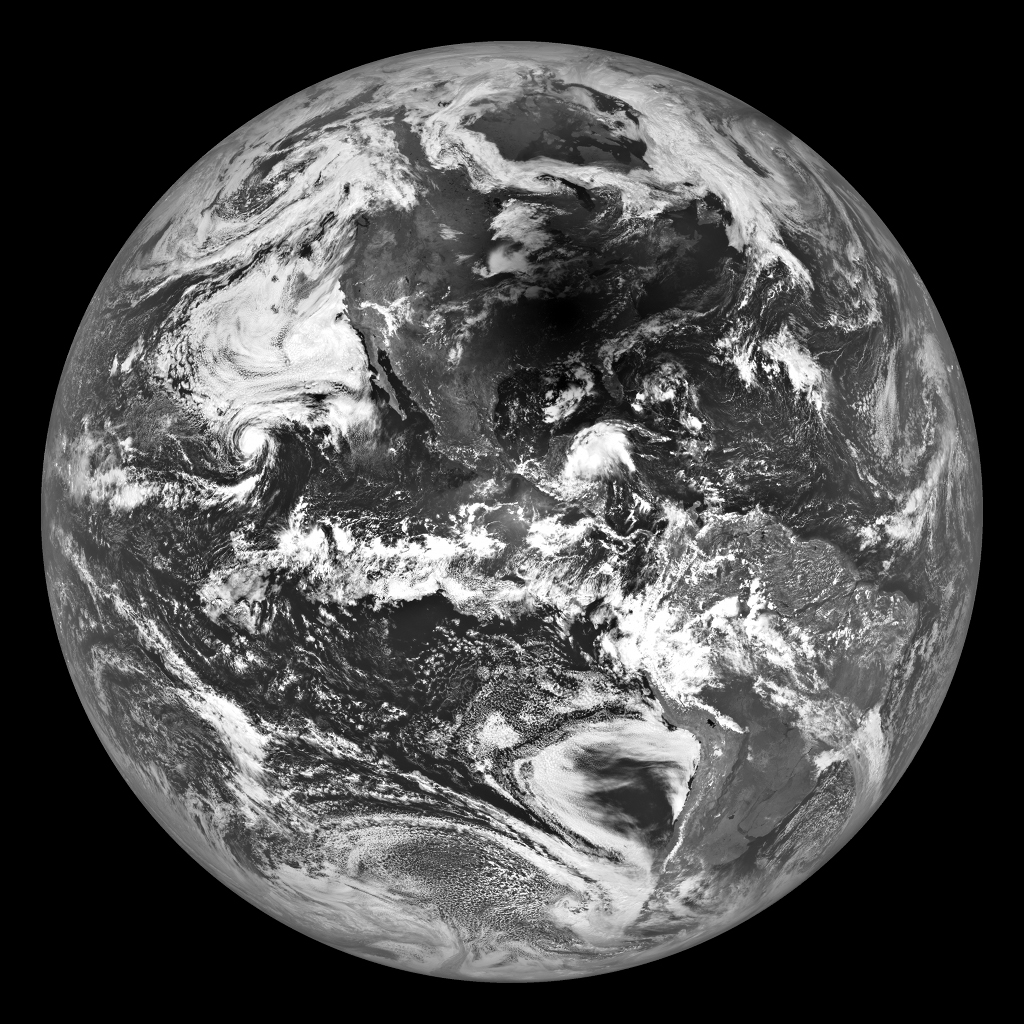 Lunar View, Solar Eclipse Image Credit: NASA / GSFC / Arizona State Univ. / Lunar Reconnaissance Orbiter Explanation: Orbiting above the lunar nearside on August 21, the Lunar Reconnaissance Orbiter turned to look back on a bright, Full Earth. As anticipated its Narrow Angle Camera scanned this sharp view of our fair planet, catching the shadow of the Moon racing along a path across the United States at about 1,500 miles per hour. In fact, the dark lunar shadow is centered over Hopkinsville, Kentucky at 1:25:30 Central Daylight Time. From there, the New Moon blocked the Sun high in clear skies for about 2 minutes and 40 seconds in a total solar eclipse. Tomorrow's picture: pixels in space ΠΗΓΗ: http://apod.nasa.gov/apod/astropix.html
__________________
VmF Skisters of Mercy © An eye for an eye, will make us all blind... Mahatma Ghandi |
 |
#3917
|
 |
|
||||
|
Astronomy Picture of the Day Discover the cosmos! Each day a different image or photograph of our fascinating universe is featured, along with a brief explanation written by a professional astronomer. 1 Sep 2017  A First Glimpse of the Great American Eclipse Image Credit & Copyright: Babak Tafreshi (TWAN) Explanation: Making landfall in Oregon, the Moon's dark umbral shadow toured the United States on August 21. Those gathered along its coast to coast path were witness to a total eclipse of the Sun, possibly the most widely shared celestial event in history. But first, the Moon's shadow touched the northern Pacific and raced eastward toward land. This dramatic snapshot was taken while crossing the shadow path 250 miles off the Oregon coast, 45,000 feet above the cloudy northern Pacific. Though from a shorter totality, it captures the eclipse before it could be seen from the US mainland. With the eclipsed Sun not far above, beautiful colors appear along the western horizon giving way to a clear, pitch-black, stratospheric sky in the shadow of the Moon. Tomorrow's picture: long voyager ΠΗΓΗ: http://apod.nasa.gov/apod/astropix.html
__________________
VmF Skisters of Mercy © An eye for an eye, will make us all blind... Mahatma Ghandi |
 |
#3918
|
 |
|
||||
|
Astronomy Picture of the Day Discover the cosmos! Each day a different image or photograph of our fascinating universe is featured, along with a brief explanation written by a professional astronomer. 3 Sep 2017 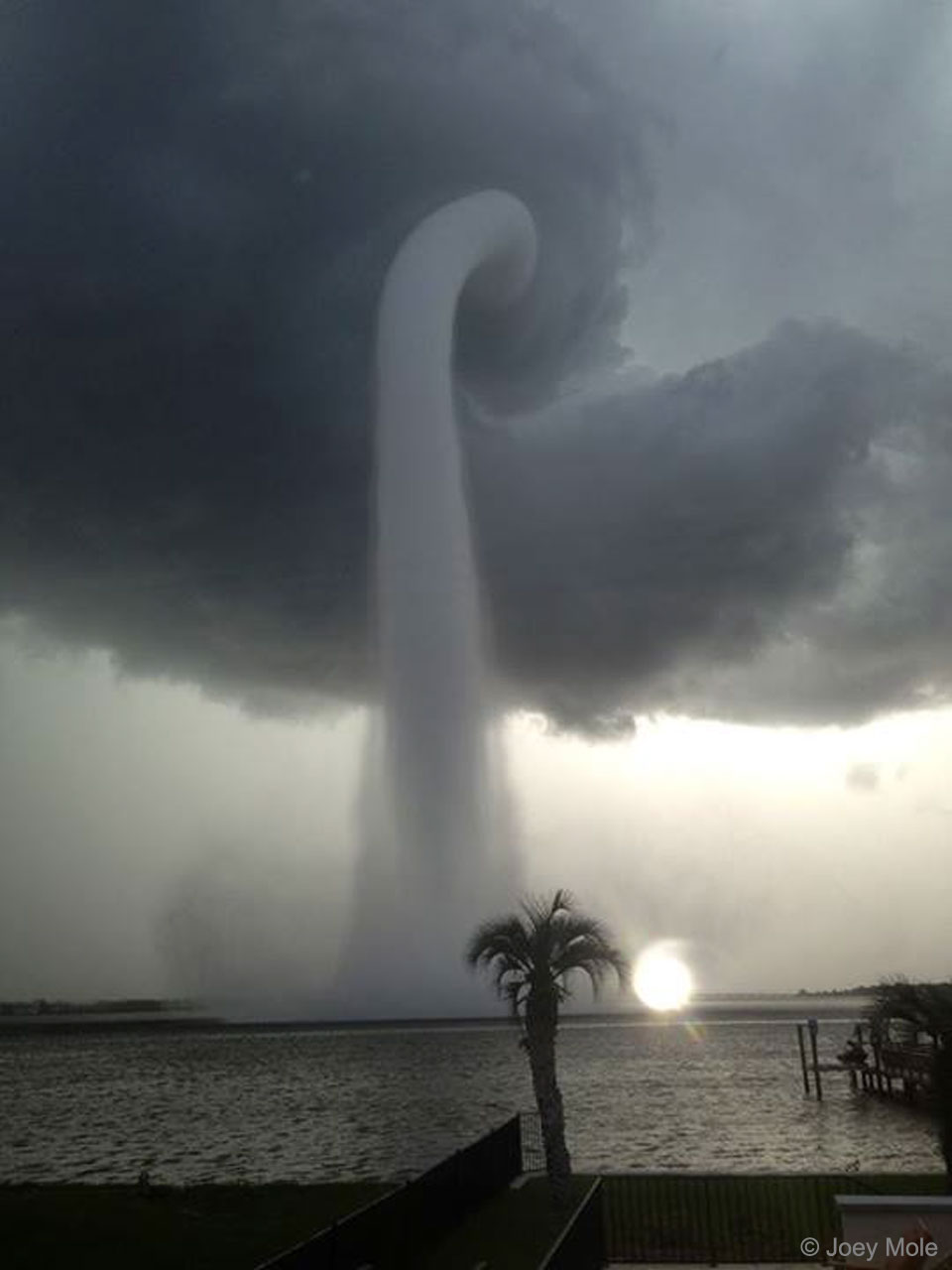 A Waterspout in Florida Image Credit & Copyright: Joey Mole Explanation: What's happening over the water? Pictured here is one of the better images yet recorded of a waterspout, a type of tornado that occurs over water. Waterspouts are spinning columns of rising moist air that typically form over warm water. Waterspouts can be as dangerous as tornadoes and can feature wind speeds over 200 kilometers per hour. Some waterspouts form away from thunderstorms and even during relatively fair weather. Waterspouts may be relatively transparent and initially visible only by an unusual pattern they create on the water. The featured image was taken in 2013 July near Tampa Bay, Florida. The Atlantic Ocean off the coast of Florida is arguably the most active area in the world for waterspouts, with hundreds forming each year. Some people speculate that waterspouts are responsible for some of the losses recorded in the Bermuda Triangle. Tomorrow's picture: ring diver ΠΗΓΗ: http://apod.nasa.gov/apod/astropix.html
__________________
VmF Skisters of Mercy © An eye for an eye, will make us all blind... Mahatma Ghandi |
 |
#3919
|
 |
|
||||
|
Astronomy Picture of the Day Discover the cosmos! Each day a different image or photograph of our fascinating universe is featured, along with a brief explanation written by a professional astronomer. 4 Sep 2017 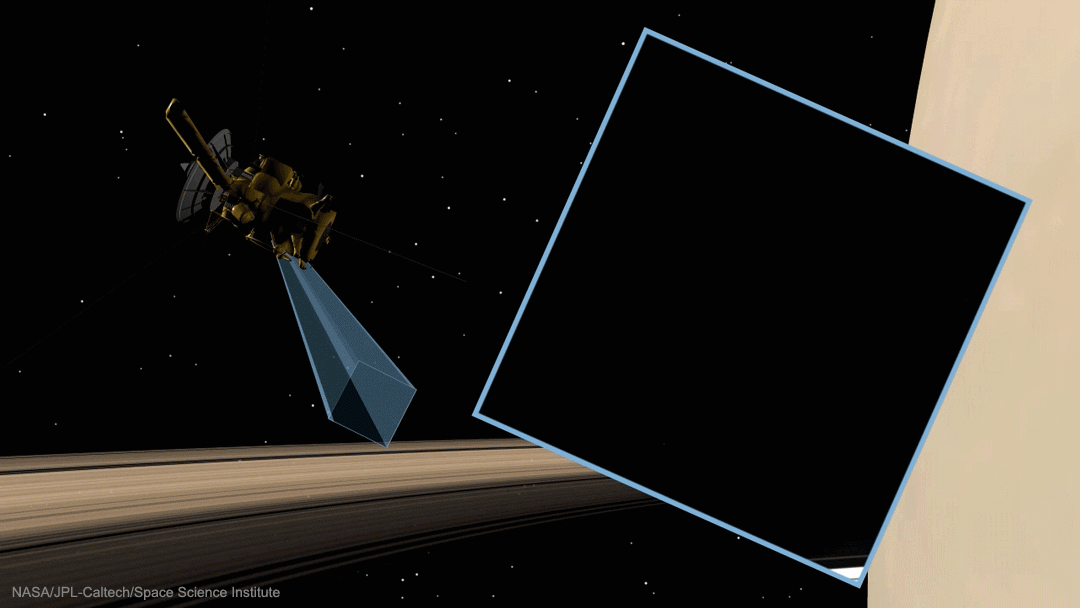 Saturn's Rings from the Inside Out Image Credit & Copyright: Joey Mole Explanation: What do Saturn's rings look like from Saturn? Images from the robotic spacecraft Cassini are providing humanity with this unprecedented vantage point as it nears the completion of its mission. Previous to Cassini's Grand Finale orbits, all images of Saturn's majestic ring system were taken from outside of the rings looking in. Pictured in the inset is the remarkable video, while the spacecraft's positions are depicted in the surrounding animation. Details of the complex rings are evident as the short time-lapse sequence begins, while the paper-thin thickness of the rings becomes apparent near the video's end. The featured images were taken on August 20. Cassini has only a few more orbits around Saturn left before it is directed to dive into the giant planet on September 15. Tomorrow's picture: voyage to the spots ΠΗΓΗ: http://apod.nasa.gov/apod/astropix.html
__________________
VmF Skisters of Mercy © An eye for an eye, will make us all blind... Mahatma Ghandi |
 |
#3920
|
 |
|
||||
|
Astronomy Picture of the Day Discover the cosmos! Each day a different image or photograph of our fascinating universe is featured, along with a brief explanation written by a professional astronomer. 5 Sep 2017  Europa and Jupiter from Voyager 1 Image Credit: NASA, Voyager 1, JPL, Caltech; Processing & License: Alexis Tranchandon / Solaris Explanation: What are those spots on Jupiter? Largest and furthest, just right of center, is the Great Red Spot -- a huge storm system that has been raging on Jupiter possibly since Giovanni Cassini's likely notation of it 352 years ago. It is not yet known why this Great Spot is red. The spot toward the lower left is one of Jupiter's largest moons: Europa. Images from Voyager in 1979 bolster the modern hypothesis that Europa has an underground ocean and is therefore a good place to look for extraterrestrial life. But what about the dark spot on the upper right? That is a shadow of another of Jupiter's large moons: Io. Voyager 1 discovered Io to be so volcanic that no impact craters could be found. Sixteen frames from Voyager 1's flyby of Jupiter in 1979 were recently reprocessed and merged to create the featured image. Forty years ago today, Voyager 1 launched from Earth and started one of the greatest explorations of the Solar System ever. Tomorrow's picture: eclipse climber ΠΗΓΗ: http://apod.nasa.gov/apod/astropix.html
__________________
VmF Skisters of Mercy © An eye for an eye, will make us all blind... Mahatma Ghandi |
 |
#3921
|
 |
|
||||
|
Astronomy Picture of the Day Discover the cosmos! Each day a different image or photograph of our fascinating universe is featured, along with a brief explanation written by a professional astronomer. 6 Sep 2017 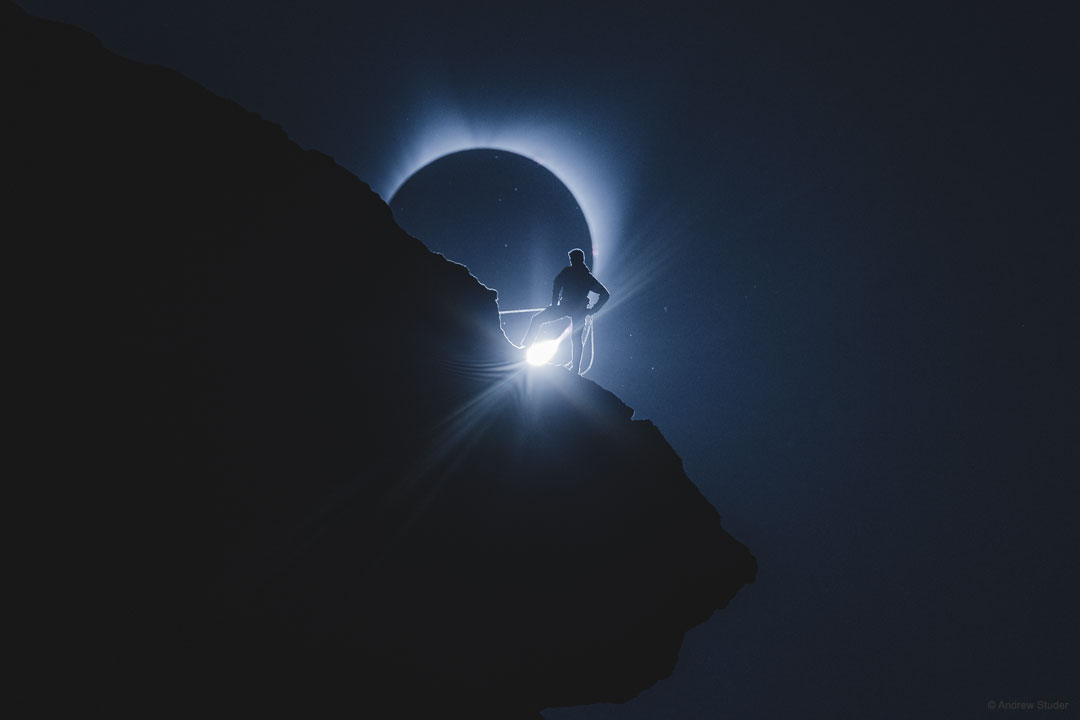 The Climber and the Eclipse Image Credit & Copyright: Andrew Struder Explanation: What should you do if your rock climbing picture is photobombed by a total eclipse of the Sun? Rejoice -- because your planning paid off. After months of considering different venues, and a week of scouting different locations in Oregon's Smith Rock State Park, a group of photographers and rock climbers led by Ted Hesser, Martina Tibell, and Michael Shainblum settled on picturesque 100-meter tall Monkey Face tower as the dramatic foreground for their images of the pending total solar eclipse. Tension mounted as the eclipse time approached, planned juxtapositions were scrutinized, and the placement of rock climber Tommy Smith was adjusted. Right on schedule, though, the Moon moved in front of the Sun, and Smith moved in front of the Moon, just as planned. The solar eclipse image displayed here actually shows a diamond ring, an eclipse phase when a bit of the distant Sun is still visible beyond the Moon's surface. Tomorrow's picture: open space ΠΗΓΗ: http://apod.nasa.gov/apod/astropix.html
__________________
VmF Skisters of Mercy © An eye for an eye, will make us all blind... Mahatma Ghandi |
 |
#3922
|
 |
|
||||
|
Astronomy Picture of the Day Discover the cosmos! Each day a different image or photograph of our fascinating universe is featured, along with a brief explanation written by a professional astronomer. 10 Sep 2017 Swirling Around the Eye of Hurricane Irma Video Credit: NASA, GOES-16 Satellite, SPoRT Explanation: Why does a hurricane have an eye at its center? No one is yet sure. What happens in and around a hurricane's eye is well documented, though. Warm air rises around the eye's edges, cools, swirls, and spreads out over the large storm, sinking primarily at the far edges. Inside the low-pressure eye, air also sinks and warms -- which causes evaporation, calm, and clearing -- sunlight might even stream through. Just at the eye's edge is a towering eyewall, the area of the highest winds. It is particularly dangerous to go outside when the tranquil eye passes over because you are soon to experience, again, the storm's violent eyewall. Featured is one of the most dramatic videos yet taken of an eye and rotating eyewall. The time-lapse video was taken from space by NASA's GOES-16 satellite last week over one of the most powerful tropical cyclones in recorded history: Hurricane Irma. Hurricanes can be extremely dangerous and their perils are not confined to the storm's center. Tomorrow's picture: approaching saturn ΠΗΓΗ: http://apod.nasa.gov/apod/astropix.html
__________________
VmF Skisters of Mercy © An eye for an eye, will make us all blind... Mahatma Ghandi |
 |
#3923
|
 |
|
||||
|
Astronomy Picture of the Day Discover the cosmos! Each day a different image or photograph of our fascinating universe is featured, along with a brief explanation written by a professional astronomer. 13 Sep 2017 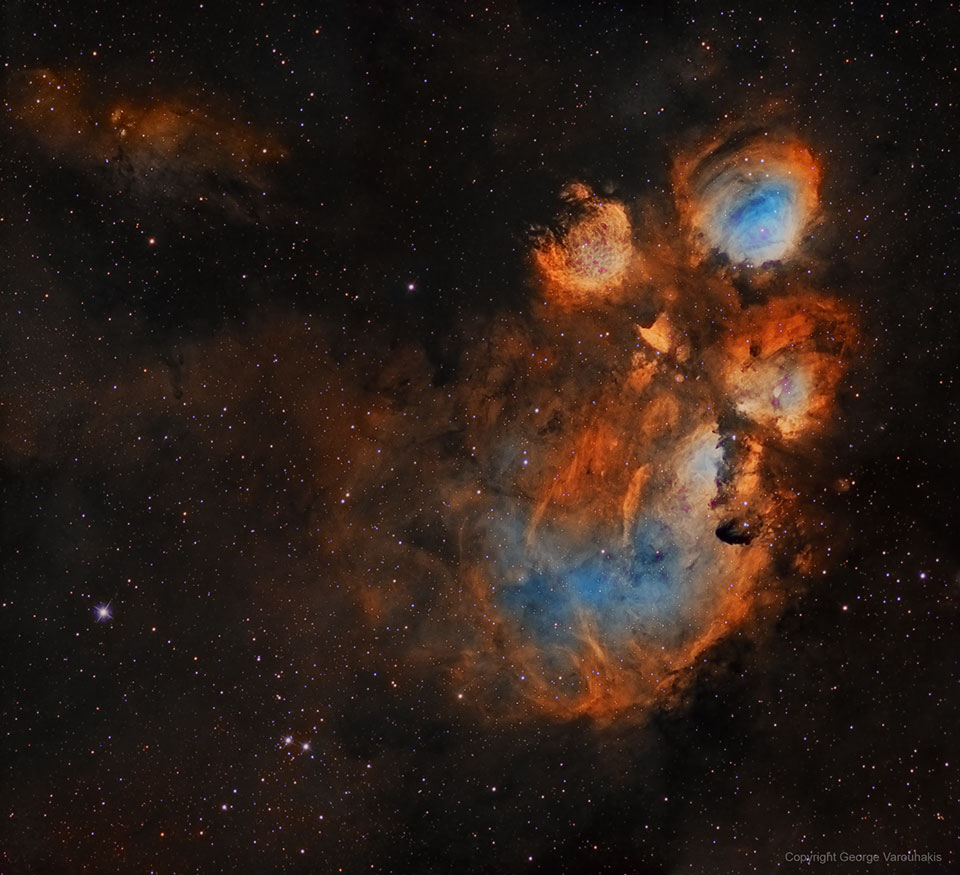 NGC 6334: The Cat's Paw Nebula Image Credit & Copyright: George Varouhakis Explanation: Nebulas are perhaps as famous for being identified with familiar shapes as perhaps cats are for getting into trouble. Still, no known cat could have created the vast Cat's Paw Nebula visible in Scorpius. At 5,500 light years distant, Cat's Paw is an emission nebula with a red color that originates from an abundance of ionized hydrogen atoms. Alternatively known as the Bear Claw Nebula or NGC 6334, stars nearly ten times the mass of our Sun have been born there in only the past few million years. Pictured here is a deep field image of the Cat's Paw Nebula in light emitted by hydrogen, oxygen, and sulfur. Tomorrow's picture: open space ΠΗΓΗ: http://apod.nasa.gov/apod/astropix.html
__________________
VmF Skisters of Mercy © An eye for an eye, will make us all blind... Mahatma Ghandi |
 |
#3924
|
 |
|
||||
|
Astronomy Picture of the Day Discover the cosmos! Each day a different image or photograph of our fascinating universe is featured, along with a brief explanation written by a professional astronomer. 15 Sep 2017 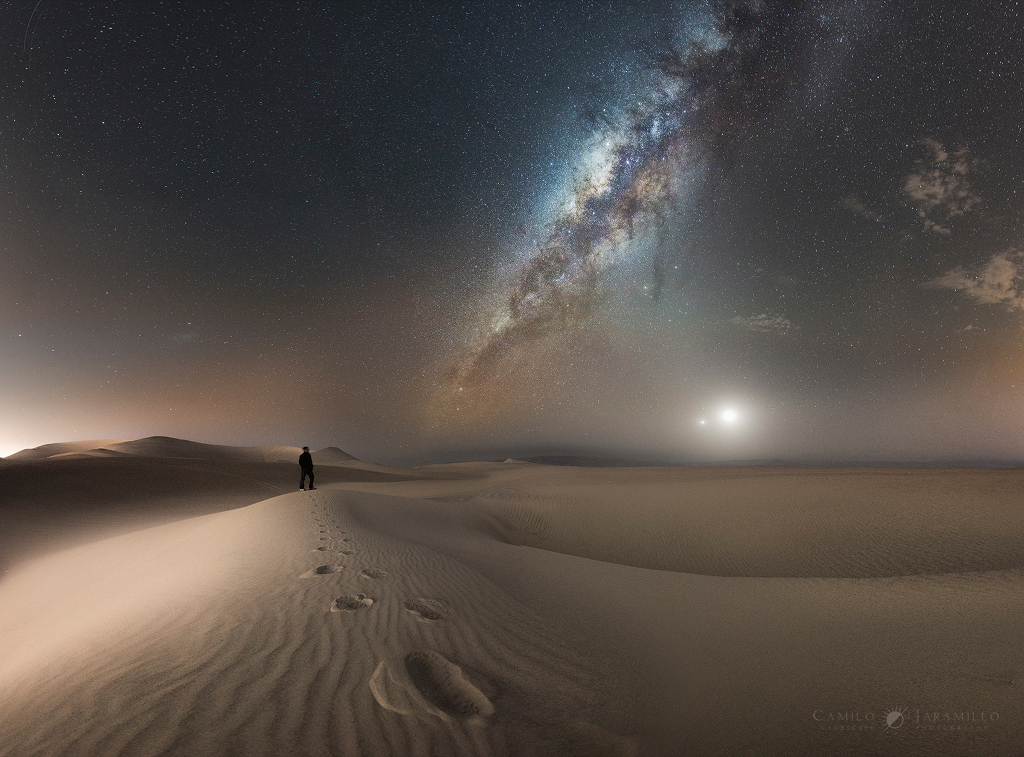 100 Steps Forward Image Credit & Copyright: Camilo Jaramillo Explanation: A beautiful conjunction of Venus and Moon, human, sand, and Milky Way is depicted in this night skyscape from planet Earth. The scene is a panorama of 6 photos taken in a moment near the end of a journey. In the foreground, footsteps along the wind-rippled dunes are close to the Huacachina oasis in the southwestern desert of Peru. An engaging perspective on the world at night, the stunning final image was also chosen as a winner in The World at Night's 2017 International Earth and Sky Photo Contest. Tomorrow's picture: light-weekend ΠΗΓΗ: http://apod.nasa.gov/apod/astropix.html
__________________
VmF Skisters of Mercy © An eye for an eye, will make us all blind... Mahatma Ghandi |
 |
#3925
|
 |
|
||||
|
Astronomy Picture of the Day Discover the cosmos! Each day a different image or photograph of our fascinating universe is featured, along with a brief explanation written by a professional astronomer. 19 Sep 2017 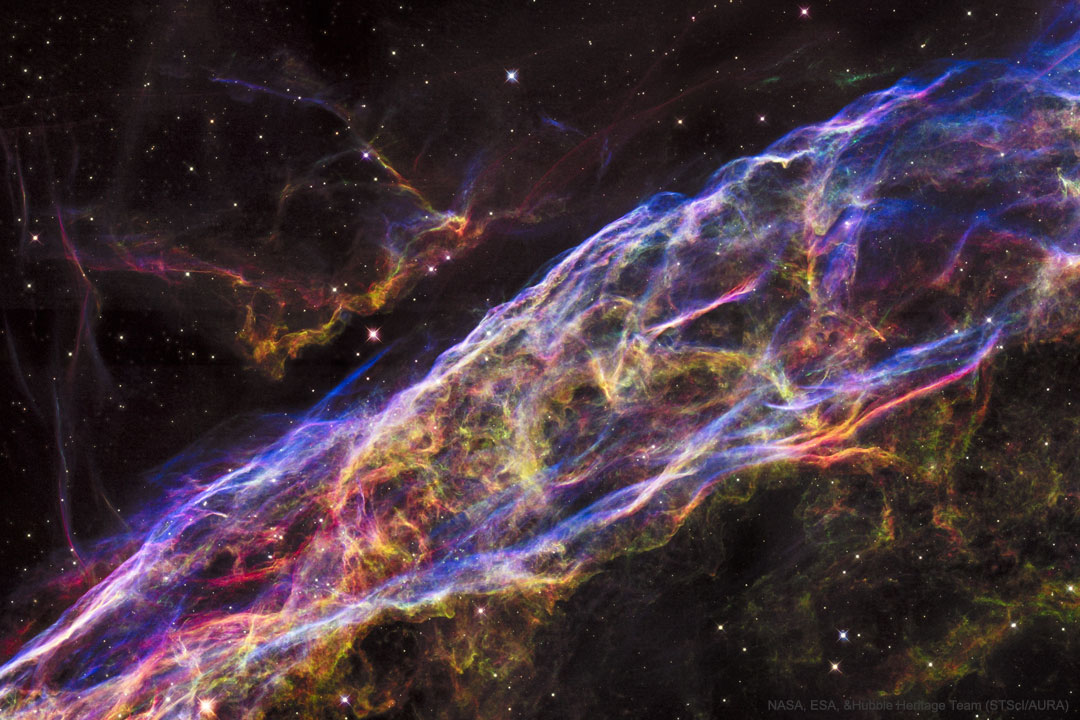 Veil Nebula: Wisps of an Exploded Star Image Credit: NASA, ESA, and the Hubble Heritage Team (STScI/AURA) Explanation: Wisps like this are all that remain visible of a Milky Way star. About 7,000 years ago that star exploded in a supernova leaving the Veil Nebula. At the time, the expanding cloud was likely as bright as a crescent Moon, remaining visible for weeks to people living at the dawn of recorded history. Today, the resulting supernova remnant, also known as the Cygnus Loop, has faded and is now visible only through a small telescope directed toward the constellation of the Swan (Cygnus). The remaining Veil Nebula is physically huge, however, and even though it lies about 1,400 light-years distant, it covers over five times the size of the full Moon. The featured picture is a Hubble Space Telescope mosaic of six images together covering a span of only about two light years, a small part of the expansive supernova remnant. In images of the complete Veil Nebula, even studious readers might not be able to identify the featured filaments. Tomorrow's picture: the big corona ΠΗΓΗ: http://apod.nasa.gov/apod/astropix.html
__________________
VmF Skisters of Mercy © An eye for an eye, will make us all blind... Mahatma Ghandi |
 |
#3926
|
 |
|
||||
|
Astronomy Picture of the Day Discover the cosmos! Each day a different image or photograph of our fascinating universe is featured, along with a brief explanation written by a professional astronomer. 20 Sep 2017 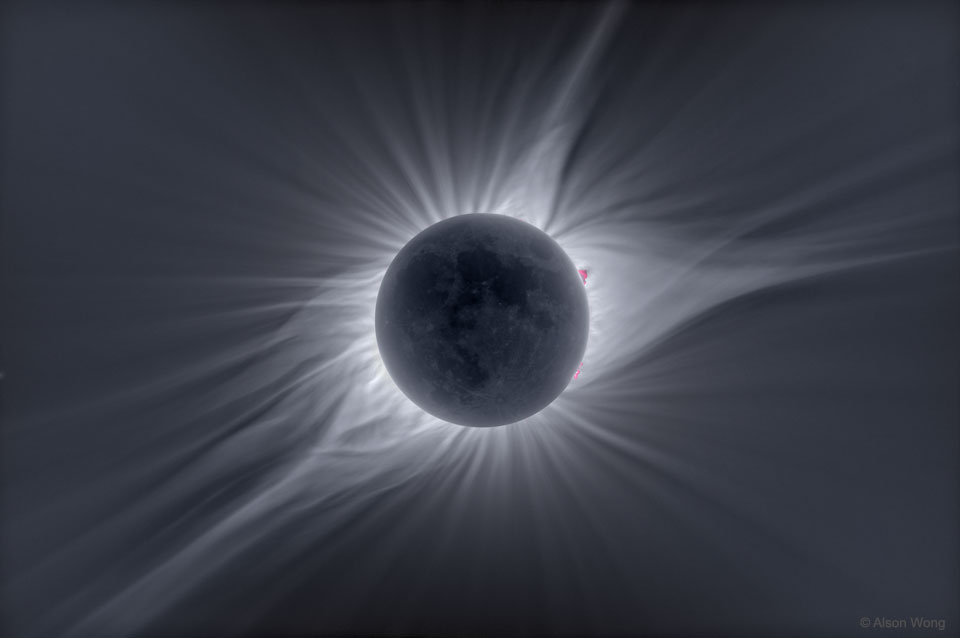 The Big Corona Image Credit & Copyright: Alson Wong Explanation: Most photographs don't adequately portray the magnificence of the Sun's corona. Seeing the corona first-hand during a total solar eclipse is unparalleled. The human eye can adapt to see coronal features and extent that average cameras usually cannot. Welcome, however, to the digital age. The featured picture is a combination of forty exposures from one thousandth of a second to two seconds that, together, were digitally combined and processed to highlight faint features of the total solar eclipse that occurred in August of 2017. Clearly visible are intricate layers and glowing caustics of an ever changing mixture of hot gas and magnetic fields in the Sun's corona. Looping prominences appear bright pink just past the Sun's limb. Faint details on the night side of the New Moon can even be made out, illuminated by sunlight reflected from the dayside of the Full Earth. Tomorrow's picture: open space ΠΗΓΗ: http://apod.nasa.gov/apod/astropix.html
__________________
VmF Skisters of Mercy © An eye for an eye, will make us all blind... Mahatma Ghandi |
 |
#3927
|
 |
|
||||
|
Astronomy Picture of the Day Discover the cosmos! Each day a different image or photograph of our fascinating universe is featured, along with a brief explanation written by a professional astronomer. 22 Sep 2017 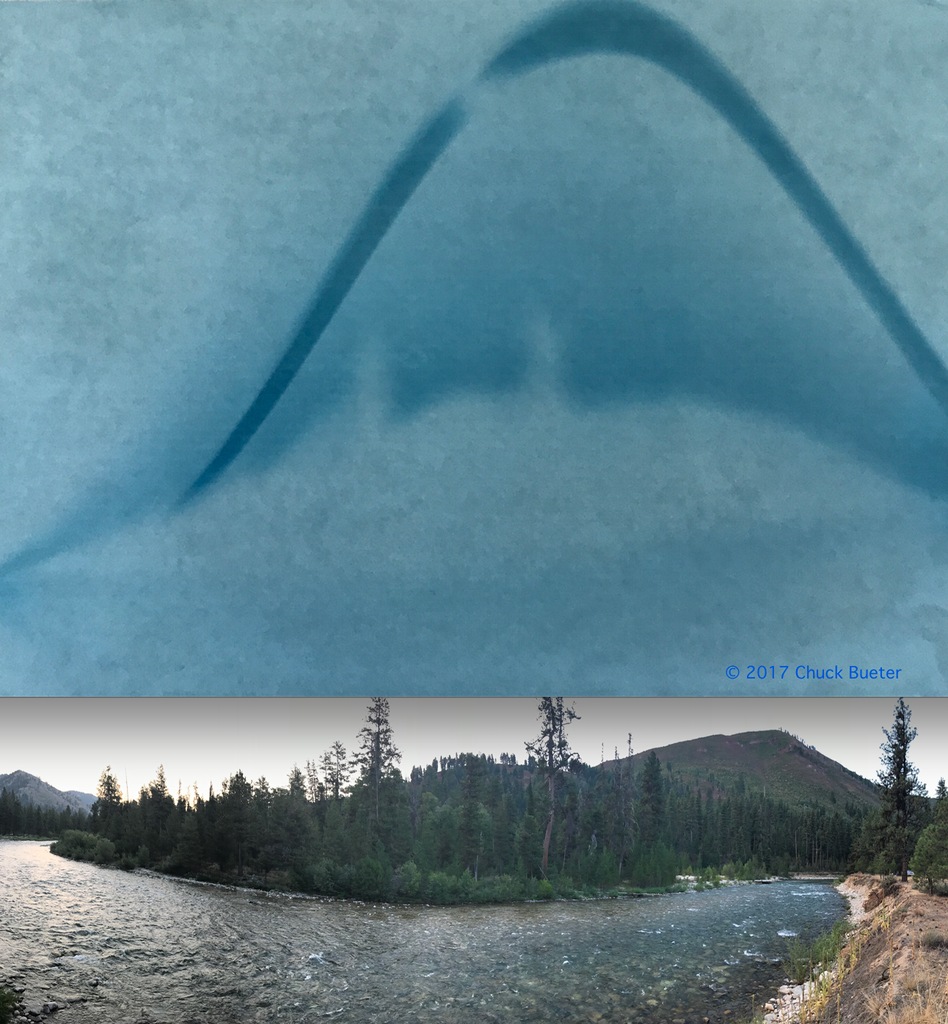 Solar Eclipse Solargraph Image Credit & Copyright: Chuck Bueter (Nightwise.org) Explanation: Today is the September equinox. Heading south, the Sun's path through the sky will cross the celestial equator at 20:02 UT. Of course the equinox date results in (mostly) equal night and day all over planet Earth. But on August 21 the Sun's path through the sky found a little extra-night for some. Made with a drink can pinhole camera and light-sensitive paper, this creative solargraph follows the Sun's path on that date. An all-day exposure, it traces the Sun's arc still rising high in northern skies, aligned with a panoramic snapshot of the local landscape at the bottom. The gap in the arc represents the duration of the partial and total phases of the solar eclipse in clear skies over Lowman, Idaho, USA. There, the extra-night (totality) lasted for about 2 minutes. The broad gap in the Sun's arc also covers the loss of sunlight during the more extended partial eclipse phases. Tomorrow's picture: a few light-minutes ΠΗΓΗ: http://apod.nasa.gov/apod/astropix.html
__________________
VmF Skisters of Mercy © An eye for an eye, will make us all blind... Mahatma Ghandi |
 |
#3928
|
 |
|
||||
|
Astronomy Picture of the Day Discover the cosmos! Each day a different image or photograph of our fascinating universe is featured, along with a brief explanation written by a professional astronomer. 23 Sep 2017 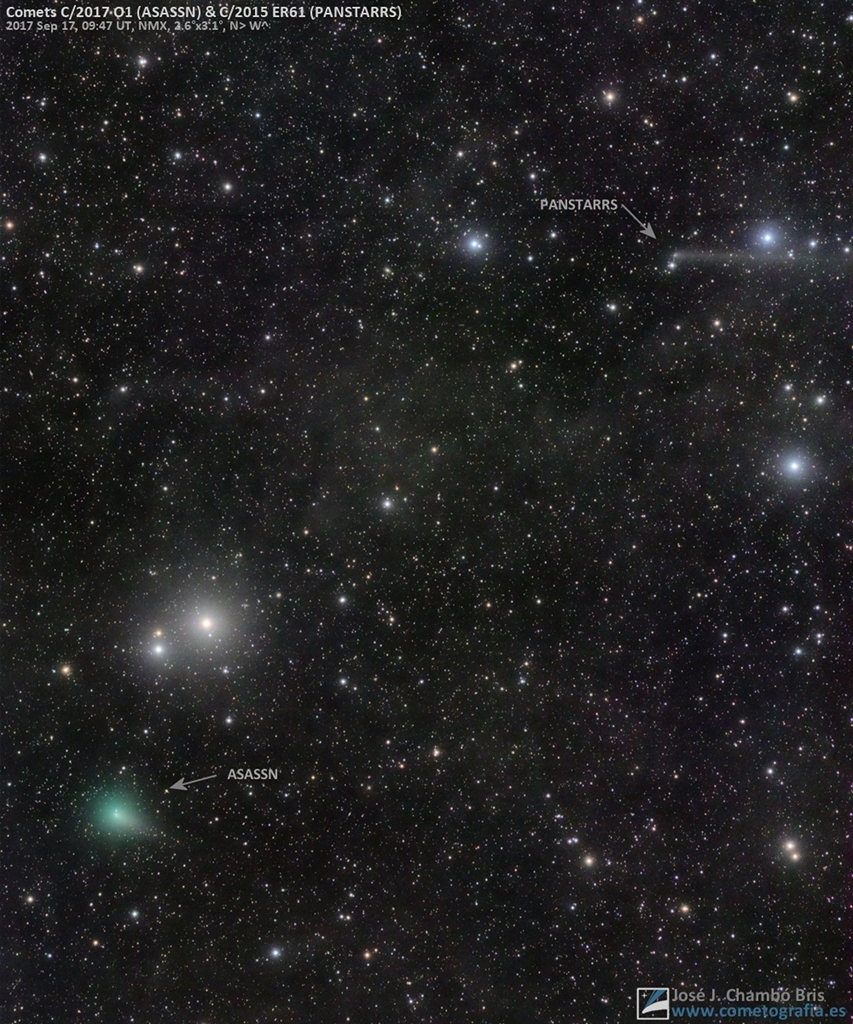 A Conjunction of Comets Image Credit & Copyright: Jose J. Chambo (Cometografia) Explanation: A conjunction of comets is captured in this pretty star field from the morning of September 17. Discovered in July by a robotic sky survey searching for supernovae, comet C/2017 O1 ASASSN is at the lower left. The visible greenish glow of its coma is produced by the fluorescence of diatomic carbon molecules in sunlight. Nearing its closest approach to the Sun, the binocular comet was only about 7.2 light-minutes from Earth. In the same telescopic field of view is the long-tailed, outbound comet C/2015 ER61 PanSTARRS at the upper right, almost 14 light-minutes away. Many light-years distant, the starry background includes faint, dusty nebulae of the Milky Way. The well-known Pleiades star cluster lies just off the top right of the frame. Tomorrow's picture: a light unknown ΠΗΓΗ: http://apod.nasa.gov/apod/astropix.html
__________________
VmF Skisters of Mercy © An eye for an eye, will make us all blind... Mahatma Ghandi |
 |
#3929
|
 |
|
||||
|
Astronomy Picture of the Day Discover the cosmos! Each day a different image or photograph of our fascinating universe is featured, along with a brief explanation written by a professional astronomer. 24 Sep 2017  How to Identify that Light in the Sky Image Credit & Copyright: HK (The League of Lost Causes) Explanation: What is that light in the sky? Perhaps one of humanity's more common questions, an answer may result from a few quick observations. For example -- is it moving or blinking? If so, and if you live near a city, the answer is typically an airplane, since planes are so numerous and so few stars and satellites are bright enough to be seen over the din of artificial city lights. If not, and if you live far from a city, that bright light is likely a planet such as Venus or Mars -- the former of which is constrained to appear near the horizon just before dawn or after dusk. Sometimes the low apparent motion of a distant airplane near the horizon makes it hard to tell from a bright planet, but even this can usually be discerned by the plane's motion over a few minutes. Still unsure? The featured chart gives a sometimes-humorous but mostly-accurate assessment. Dedicated sky enthusiasts will likely note -- and are encouraged to provide -- polite corrections. Tomorrow's picture: cygnus x ΠΗΓΗ: http://apod.nasa.gov/apod/astropix.html
__________________
VmF Skisters of Mercy © An eye for an eye, will make us all blind... Mahatma Ghandi |
 |
#3930
|
 |
|
||||
|
Astronomy Picture of the Day Discover the cosmos! Each day a different image or photograph of our fascinating universe is featured, along with a brief explanation written by a professional astronomer. 25 Sep 2017 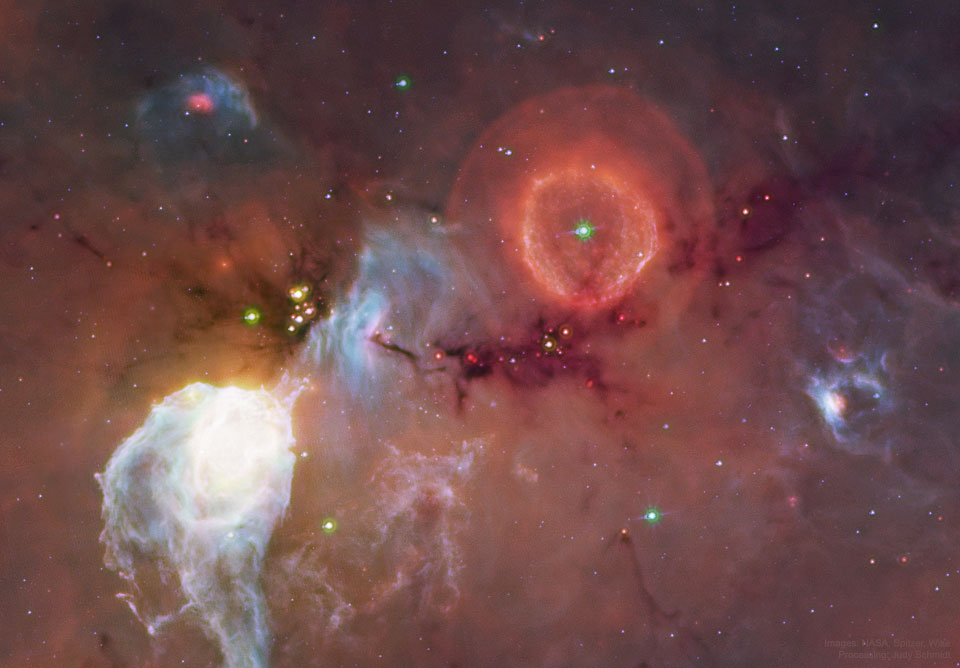 Massive Shell-Expelling Star G79.29+0.46 Image Credit: NASA, Spitzer Space Telescope, WISE; Processing & License : Judy Schmidt Explanation: Stars this volatile are quite rare. Captured in the midst of dust clouds and visible to the right and above center is massive G79.29+0.46, one of less than 100 luminous blue variable stars (LBVs) currently known in our Galaxy. LBVs expel shells of gas and may lose even the mass of Jupiter over 100 years. The star, itself bright and blue, is shrouded in dust and so not seen in visible light. The dying star appears green and surrounded by red shells, though, in this mapped-color infrared picture combining images from NASA's Spitzer Space Observatory and NASA's Wide-Field Infrared Survey Explorer. G79.29+0.46 is located in the star-forming Cygnus X region of our Galaxy. Why G79.29+0.46 is so volatile, how long it will remain in the LBV phase, and when it will explode in a supernova is not known. Tomorrow's picture: a farewell to saturn ΠΗΓΗ: http://apod.nasa.gov/apod/astropix.html
__________________
VmF Skisters of Mercy © An eye for an eye, will make us all blind... Mahatma Ghandi |
 |
| Συνδεδεμένοι χρήστες που διαβάζουν αυτό το θέμα: 10 (0 μέλη και 10 επισκέπτες) | |
|
|